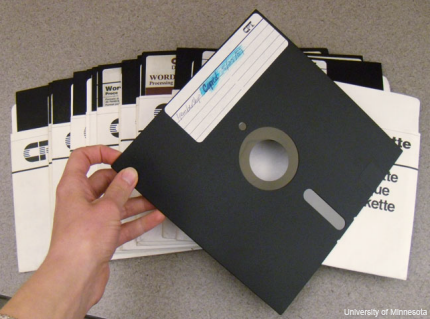Nuclear arsenal finds security in 8-inch floppy disks
The decades-old technology at the Air Force‘s missile silos has its advantages.

The 8-inch floppy disk is to computers what the hand crank starter is to automobiles—a relic of the past, existing in museums, black-and-white photos and maybe your grandfather’s basement.
They’re the stuff of computer nostalgia, finding themselves made into a desk clock, attached to a tote bag or throw pillow, or emblazoned on a T-shirt. And they can also be used to launch intercontinental ballistic missiles.
In a “60 minutes” report Sunday, correspondent Leslie Stahl visited an Air Force launch control center in Wyoming and discovered that Cold War-era facilities still have Cole War-era technology, including analog phones and, yes, 8-inch floppy disks that are used in issuing launch commands for the Minuteman missiles.
ICBM missile silos went up in the 1960s and ‘70s and have remained pretty much frozen in time. The missiles themselves have undergone regular upgrades, but the facilities haven’t changed much. One reason is money—according to one estimate, it would cost $352 billion over the next decade to modernize the facilities. But another reason is the security provided by old IT.
Maj. Gen. Jack Weinstein, commander of ICBM forces, told Stahl that the old hardware and software, and the lack of an Internet connection, provides solid security for the missile bases.
That makes sense, since it’s unlikely that a hacker today would have much experience with an 8-inch floppy. In fact, one of the “missileers” at the base told Stahl she had never seen one before arriving there. The disks also have a built-in protection against portable-storage attacks like Stuxnet, which was introduced to Iran’s Natanz nuclear plant via a thumb drive, since the disks don’t have nearly enough space to hold such a sophisticated piece of malware.
The 8-inch floppy was created in 1967 by IBM as a way to provide software updates for its System/370 mainframes. The first “memory disk,” as it was called, held 80 kilobytes of data. IBM introduced the floppy commercially in 1971, and by 1976 new floppies were double-sided disks that could hold 1-1.2megabytes. But they had been pretty much overtaken by 5½-inch disks by the time the PC revolution got going in the early 1980s. Since then, portable storage has steadily gotten smaller, faster and more capacious as the 8-inch floppy faded into history.
But not altogether, as their presence at the ICBM bases shows. In fact, pockets of government, with its duty to keep and manage all kinds of records, still work with the floppies, if not of the 8-inch variety. The Federal Register still accepts 3½-inch floppies along with CD-ROMs (though not flash drives or SD cards), and the Library of Congress still uses them to construct details of history in the computer era.
As reliable as the disks have been, however, age could become a concern. Digital media won’t last forever. The Wyoming launch center is planning to upgrade from its analog phones, which have proven to be unreliable, according to the “60 Minutes” report. And the Air Force reportedly will spend $19 million on upgrades to the launch centers this year and has requested $600 million for further improvements next year.
Whether that includes moving on from floppies isn’t clear, but in the meantime, they can always turn to eBay for an unopened, unused “box of 10 rare Intel double sided/double density 8- inch floppy disks,” for $44.95, plus $14.83 for expedited shipping. If need be, they can even find refurbished 8-inch floppy diskette drives for $1,211.77. That is, if the launch center had an Internet connection.
NEXT STORY: Navy forms team to boost shipboard cybersecurity




